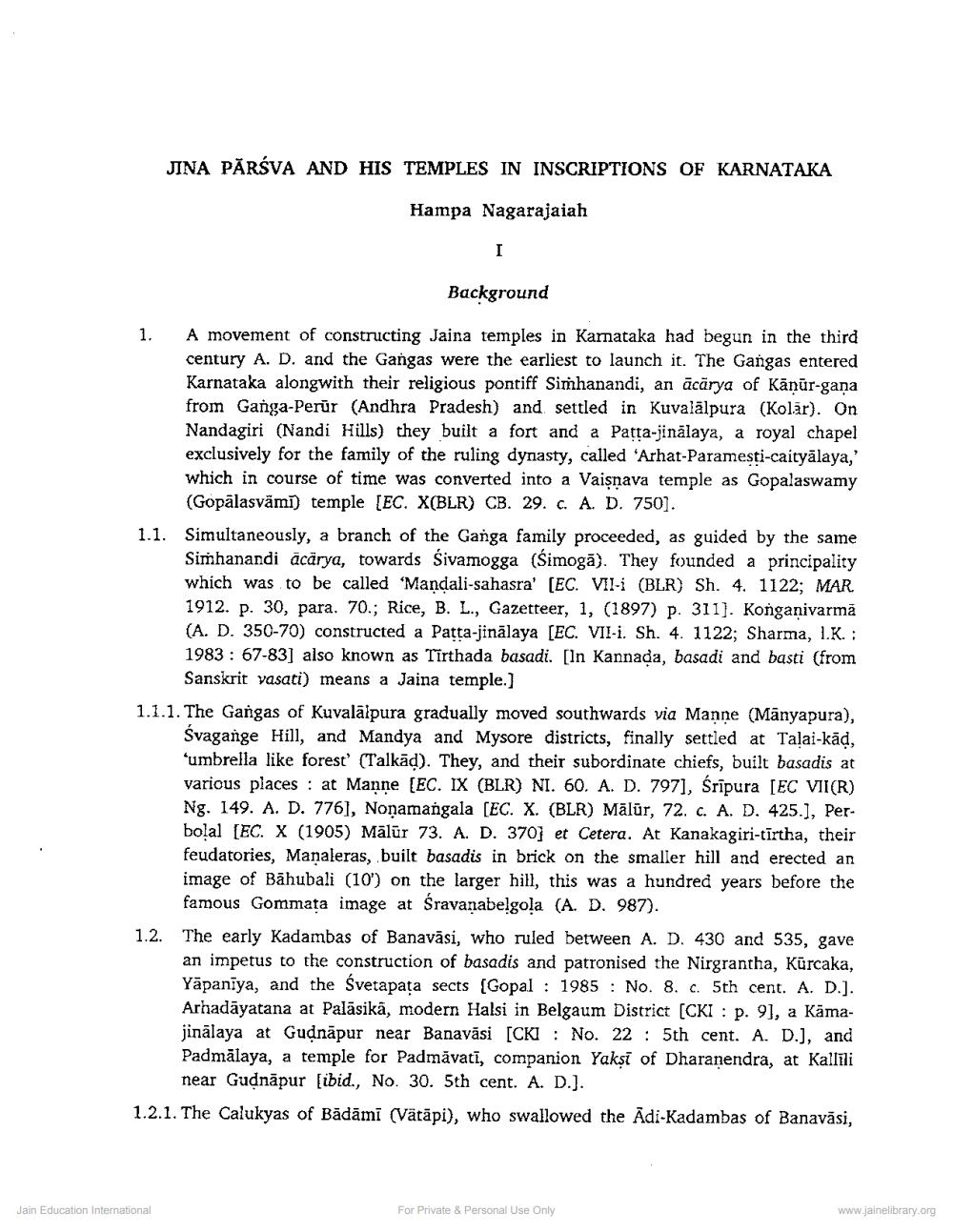Book Title: Jin Parsva and His Temples in Inscriptions of Karnataka Author(s): Hampa Nagrajaiha Publisher: Z_Nirgrantha_1_022701.pdf and Nirgrantha_2_022702.pdf and Nirgrantha_3_022703.pdf View full book textPage 1
________________ JINA PĂRÁVA AND HIS TEMPLES IN INSCRIPTIONS OF KARNATAKA Hampa Nagarajaiah Background 1. A movement of constructing Jaina temples in Karnataka had begun in the third century A. D. and the Gangas were the earliest to launch it. The Gangas entered Karnataka alongwith their religious pontiff Simhanandi, an ācārya of Kānūr-gana from Ganga-Perür (Andhra Pradesh) and settled in Kuvalälpura (Kolār). On Nandagiri (Nandi Hills) they built a fort and a Patta-jinälaya, a royal chapel exclusively for the family of the ruling dynasty, called 'Arhat-Paramesti-caityālaya,' which in course of time was converted into a Vaisnava temple as Gopalaswamy (Gopālasvämī) temple (EC. X(BLR) CB. 29. c. A. D. 750). 1.1. Simultaneously, a branch of the Ganga family proceeded, as guided by the same Simhanandi äcärya, towards Śivamogga (Simogā). They founded a principality which was to be called "Mandali-sahasra' (EC. VII-i (BLR) Sh. 4. 1122; MAR. 1912. p. 30, para. 70.; Rice, B. L., Gazetteer, 1, (1897) p. 311). Konganivarmā (A. D. 350-70) constructed a Patta-jinālaya (EC. VII-i. Sh. 4. 1122; Sharma, I.K. : 1983: 67-83] also known as Tirthada basadi. [In Kannada, basadi and basti (from Sanskrit vasati) means a Jaina temple.) 1.1.1. The Gangas of Kuvalāłpura gradually moved southwards via Manne (Mānyapura), Svagange Hill, and Mandya and Mysore districts, finally settled at Talai-kād, ‘umbrella like forest (Talkād). They, and their subordinate chiefs, built basadis at various places : at Manne (EC. IX (BLR) NI. 60. A. D. 797], Śrīpura [EC VII(R) Ng. 149. A. D. 776], Nonamangala (EC. X. (BLR) Mālür, 72. c. A. D. 425.), Perbolal [EC. X (1905) Mālür 73. A. D. 370] et Cetera. At Kanakagiri-tīrtha, their feudatories, Manaleras, built basadis in brick on the smaller hill and erected an image of Bahubali (10') on the larger hill, this was a hundred years before the famous Gommata image at Śravanabelgola (A. D. 987). 1.2. The early Kadambas of Banavāsi, who ruled between A. D. 430 and 535, gave an impetus to the construction of basadis and patronised the Nirgrantha, Kurcaka, Yāpaniya, and the Svetapata sects (Gopal : 1985 : No. 8. c. 5th cent. A. D.). Arhadāyatana at Palāsikā, modern Halsi in Belgaum District (CKI: p. 9], a Kamajinālaya at Gunāpur near Banavāsi (CKI : No. 22 : 5th cent. A. D.), and Padmālaya, a temple for Padmavatī, companion Yakşi of Dharanendra, at Kallīli near Gudnäpur (ibid., No. 30. 5th cent. A. D.). 1.2.1. The Calukyas of Bädämi (Vätāpi), who swallowed the Adi-Kadambas of Banavāsi, Jain Education International For Private & Personal Use Only For Private & Personal Use Only www.jainelibrary.orgPage Navigation
1 2 3 4 5 6 7 8 9 10 11 12 ... 23
